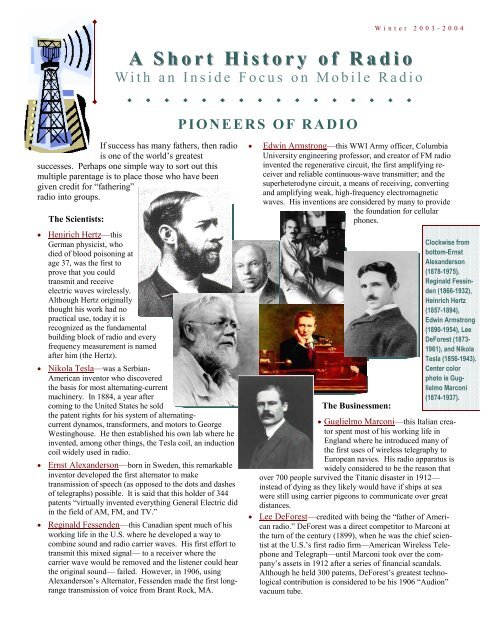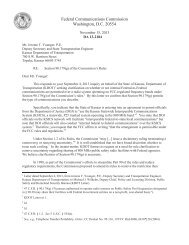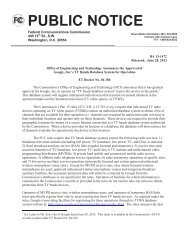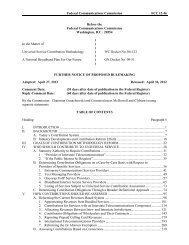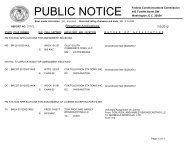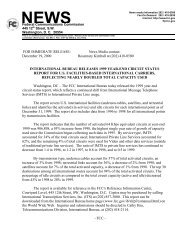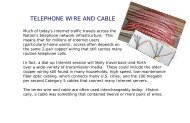You also want an ePaper? Increase the reach of your titles
YUMPU automatically turns print PDFs into web optimized ePapers that Google loves.
Winter 2003-2004<br />
A <strong>Short</strong> <strong>History</strong> <strong>of</strong> <strong>Radio</strong><br />
With an Inside Focus on Mobile <strong>Radio</strong><br />
If success has many fathers, then radio<br />
is one <strong>of</strong> the world’s greatest<br />
successes. Perhaps one simple way to sort out this<br />
multiple parentage is to place those who have been<br />
given credit for “fathering”<br />
radio into groups.<br />
The Scientists:<br />
• Henirich Hertz—this<br />
German physicist, who<br />
died <strong>of</strong> blood poisoning at<br />
age 37, was the first to<br />
prove that you could<br />
transmit and receive<br />
electric waves wirelessly.<br />
Although Hertz originally<br />
thought his work had no<br />
practical use, today it is<br />
recognized as the fundamental<br />
building block <strong>of</strong> radio and every<br />
frequency measurement is named<br />
after him (the Hertz).<br />
• Nikola Tesla—was a Serbian-<br />
American inventor who discovered<br />
the basis for most alternating-current<br />
machinery. In 1884, a year after<br />
coming to the United States he sold<br />
the patent rights for his system <strong>of</strong> alternatingcurrent<br />
dynamos, transformers, and motors to George<br />
Westinghouse. He then established his own lab where he<br />
invented, among other things, the Tesla coil, an induction<br />
coil widely used in radio.<br />
• Ernst Alexanderson—born in Sweden, this remarkable<br />
inventor developed the first alternator to make<br />
transmission <strong>of</strong> speech (as opposed to the dots and dashes<br />
<strong>of</strong> telegraphs) possible. It is said that this holder <strong>of</strong> 344<br />
patents “virtually invented everything General Electric did<br />
in the field <strong>of</strong> AM, FM, and TV.”<br />
• Reginald Fessenden—this Canadian spent much <strong>of</strong> his<br />
working life in the U.S. where he developed a way to<br />
combine sound and radio carrier waves. His first effort to<br />
transmit this mixed signal— to a receiver where the<br />
carrier wave would be removed and the listener could hear<br />
the original sound— failed. However, in 1906, using<br />
Alexanderson’s Alternator, Fessenden made the first longrange<br />
transmission <strong>of</strong> voice from Brant Rock, MA.<br />
PIONEERS OF RADIO<br />
• Edwin Armstrong—this WWI Army <strong>of</strong>ficer, Columbia<br />
University engineering pr<strong>of</strong>essor, and creator <strong>of</strong> FM radio<br />
invented the regenerative circuit, the first amplifying receiver<br />
and reliable continuous-wave transmitter; and the<br />
superheterodyne circuit, a means <strong>of</strong> receiving, converting<br />
and amplifying weak, high-frequency electromagnetic<br />
waves. His inventions are considered by many to provide<br />
the foundation for cellular<br />
phones.<br />
The Businessmen:<br />
Clockwise from<br />
bottom-Ernst<br />
Alexanderson<br />
(1878-1975),<br />
Reginald Fessinden<br />
(1866-1932),<br />
Heinrich Hertz<br />
(1857-1894),<br />
Edwin Armstrong<br />
(1890-1954), Lee<br />
DeForest (1873-<br />
1961), and Nikola<br />
Tesla (1856-1943).<br />
Center color<br />
photo is Guglielmo<br />
Marconi<br />
(1874-1937).<br />
• Guglielmo Marconi—this Italian creator<br />
spent most <strong>of</strong> his working life in<br />
England where he introduced many <strong>of</strong><br />
the first uses <strong>of</strong> wireless telegraphy to<br />
European navies. His radio apparatus is<br />
widely considered to be the reason that<br />
over 700 people survived the Titanic disaster in 1912—<br />
instead <strong>of</strong> dying as they likely would have if ships at sea<br />
were still using carrier pigeons to communicate over great<br />
distances.<br />
• Lee DeForest—credited with being the “father <strong>of</strong> American<br />
radio.” DeForest was a direct competitor to Marconi at<br />
the turn <strong>of</strong> the century (1899), when he was the chief scientist<br />
at the U.S.’s first radio firm—American Wireless Telephone<br />
and Telegraph—until Marconi took over the company’s<br />
assets in 1912 after a series <strong>of</strong> financial scandals.<br />
Although he held 300 patents, DeForest’s greatest technological<br />
contribution is considered to be his 1906 “Audion”<br />
vacuum tube.
1885<br />
1891<br />
1892<br />
to<br />
1893<br />
1896<br />
to<br />
1897<br />
1899<br />
1901<br />
1902<br />
Page 2<br />
GENERAL<br />
RADIO<br />
TIMELINE<br />
Heinrich Hertz proved<br />
that electricity can be<br />
transmitted in electromagnetic<br />
waves. He<br />
conducted experiments<br />
in sending and<br />
receiving these waves<br />
during the late 1880s.<br />
<strong>Radio</strong>s (what we’d<br />
call wireless telegraphs<br />
today) began to<br />
appear on ships at sea.<br />
This reduced the isolation<br />
<strong>of</strong> the ships thus<br />
improving both reliability<br />
and safety.<br />
Nikola Tesla wirelessly<br />
transmitted<br />
electromagnetic energy.<br />
He made the<br />
first public demonstration<br />
<strong>of</strong> radio in St.<br />
Louis in 1893.<br />
Guglielmo Marconi<br />
filed for patent protection<br />
<strong>of</strong> his radio apparatus.<br />
He established<br />
the Wireless Telegraph<br />
and Signal<br />
Company in 1897.<br />
The R.F. Matthews<br />
was the first ship to<br />
request emergency<br />
assistance using a<br />
wireless apparatus<br />
(Marconi’s system).<br />
First transAtlantic<br />
signal sent-by Marconi<br />
from Ireland to<br />
Canada.<br />
Amateur (today<br />
known as “ham”)<br />
radio introduced to the<br />
U.S. via a Scientific<br />
American article on<br />
“How to Construct an<br />
Efficient Wireless<br />
Telegraphy Apparatus<br />
at Small Cost.”<br />
...Continued on last page...<br />
T<br />
here are hundreds, if not thousands, <strong>of</strong> uses <strong>of</strong> radio<br />
spectrum and technology. Everything from baby monitors<br />
and broadcasting to radar and radio beacons are<br />
applications <strong>of</strong> radio. These two pages focus on the<br />
first historical use <strong>of</strong> radio—mobile radio.<br />
Technologies<br />
that underpin<br />
mobile radio were<br />
first put to work in<br />
the 1890s on<br />
behalf <strong>of</strong> oceangoing<br />
ships, which<br />
had previously<br />
relied on carrier<br />
pigeons and flags<br />
for their<br />
communications.<br />
In 1910, Frederick<br />
Baldwin and John<br />
McCurdy were<br />
the first to trail<br />
an aerial behind<br />
their bi-plane to<br />
demonstrate<br />
radio’s uses for<br />
aviation.<br />
In 1921, Detroit<br />
police<br />
commissioner<br />
William<br />
Rutledge was<br />
the first public safety<br />
<strong>of</strong>ficial to use radio<br />
equipped vehicles.<br />
Today, maritime, aviation,<br />
and land-based mobile radio<br />
systems remain among the<br />
most important nonbroadcast<br />
uses <strong>of</strong> the<br />
radio spectrum.<br />
But mobile radio isn’t just<br />
for safety purposes today.<br />
Taxi drivers, tow truck<br />
dispatchers,<br />
and package delivery services<br />
are just a few <strong>of</strong> the<br />
businesses that make innovative<br />
use <strong>of</strong> mobile radio.<br />
In fact, mobile radio has<br />
become such a key tool in<br />
all business communications<br />
that one <strong>of</strong> the <strong>FCC</strong>’s<br />
major challenges is ensur-<br />
Inside Focus on Mobile <strong>Radio</strong><br />
MOBILE RADIO AT WORK<br />
Robert Loraine was the<br />
second pilot to demonstrate<br />
wireless transmission<br />
from a<br />
plane (1910).<br />
Detroit police radio car<br />
with antennas running<br />
across the ro<strong>of</strong> (1921).<br />
The Titanic, showing its<br />
radio antennas strung from<br />
bow to stern (1912).<br />
ing efficient and effective<br />
use <strong>of</strong> the radio spectrum by<br />
business, while guaranteeing<br />
the reliability and interoperability<br />
<strong>of</strong> all public<br />
safety radio uses.<br />
In finding a way to make this<br />
all work, the <strong>FCC</strong> helps<br />
make America a safer and<br />
better place to live.
Inside Focus on Mobile <strong>Radio</strong><br />
CELL PHONES—ONE OF TODAY’S MOST<br />
POPULAR USES OF MOBILE RADIO<br />
Cellular phones, including Personal Communication<br />
Service devices, may seem like one <strong>of</strong> the newest<br />
land mobile services, but the idea <strong>of</strong> a mobile radio<br />
telephone has been around for quite a while.<br />
In the early 1920s both the Marconi company and the<br />
Bell Laboratories were testing car-based telephone<br />
systems. Bell Labs believes its 1924 system was<br />
actually the first two-way, voice-based radio<br />
telephone.<br />
Other predecessors to today’s cell phones included<br />
the radio telephones used by the military during both<br />
World Wars.<br />
The science behind cell phones, as we know them<br />
today, was clearly known by 1945 as evidenced by a<br />
Saturday Evening Post article, “Phone Me by Air,”<br />
which quoted <strong>FCC</strong> Commissioner E.K. Jett on<br />
frequency reuse for “small zone<br />
systems.” He said, “In each zone,<br />
the…frequencies will<br />
provide from 70 to 100 different<br />
channels, half <strong>of</strong> which<br />
may be used<br />
simultaneously in the<br />
same area without<br />
overlapping.”<br />
Although not yet a<br />
cellular system, in<br />
1946 Bell initiated<br />
America’s first<br />
commercial mobile radio<br />
telephone system. Bell,<br />
as well as Ericsson, Nokia,<br />
and Motorola then went on to<br />
develop cell phone technologies<br />
throughout the 1950s and 1960s.<br />
The <strong>FCC</strong> approved a major<br />
allocation <strong>of</strong> spectrum for mobile radio systems in<br />
1970. In 1973, Motorola’s Martin Cooper was<br />
credited with the invention <strong>of</strong> the first personal,<br />
handheld cellular radio telephone.<br />
Page 3<br />
The year after the <strong>FCC</strong> made its final 1982 decision on<br />
spectrum for cellular systems, Ameritech Mobile<br />
Communications (Chicago) and CellularOne<br />
(Washington, D.C.) became the first operational<br />
commercial cellular providers in the United States.<br />
Personal communications for people on–the-go, not just<br />
those in vehicles, evolved further in the 1990s and<br />
continues growing today.<br />
Clockwise from top right—a WWI mobile military<br />
phone, <strong>of</strong> the type Edwin Armstrong used to develop his ground-breaking<br />
inventions; Marconi’s 1922 car phone system with receivers, amplifiers, and<br />
speakers mounted on the running boards; Martin Cooper with his 1973 cellular<br />
telephone; older and newer generations <strong>of</strong> mobile radio telephones; and Bell<br />
Labs’ 1924 test <strong>of</strong> a mobile radio telephone.
Page 4<br />
WHERE TO LEARN MORE<br />
Find out more about the history and technology <strong>of</strong> radio by visiting any <strong>of</strong> the following<br />
sites:<br />
• Early <strong>Radio</strong> <strong>History</strong>—http://earlyradiohistory.us<br />
• Engineering history—http://www.ieee.org/organizations/history_center/<br />
• Electromagnetic spectrum—<br />
http://imagine.gsfc.nasa.gov/docs/science/know_l1/emspectrum.html<br />
• <strong>Radio</strong> <strong>History</strong> Society—http://www.radiohistory.org/<br />
• Surfing the Aether—http://www.northwinds.net/bchris/<br />
• Marconi Calling—http://www.marconicalling.com/front.htm<br />
• Edwin Armstrong—http://users.erols.com/oldradio/index.htm<br />
• Mobile Telephone <strong>History</strong>—http://www.privateline.com/index.html<br />
• Mobile Services—<br />
http://www.ntia.doc.gov/openness/sp_rqmnts/mobile1.html<br />
• <strong>FCC</strong> Regulation <strong>of</strong> Wireless Services—http://wireless.fcc.gov/services/<br />
WIRELESS—ONE WORD, MANY<br />
MEANINGS<br />
While a rose may smell the same regardless <strong>of</strong> what it’s called, the term “wireless”<br />
has referred to distinctly different things throughout the past century. The one common<br />
characteristic among all these uses <strong>of</strong> the word is that they all describe a communication<br />
product that sends or receives information via electromagnetic waves.<br />
• 1900s—sending a wireless meant you were aboard a ship sending a telegram<br />
to the home <strong>of</strong>fice to let them know when you’d arrive.<br />
• 1920s—listening to the wireless meant you could hear the Navy’s time and<br />
weather reports, USDA’s crop and market news, as well as concerts, lectures,<br />
and sermons.<br />
• 1980s—talking on your wireless unit meant you<br />
had a cellular or PCS telephone.<br />
• 2003—using wireless likely means taking a picture<br />
using your digital 3G-enabled cell/PCS phone<br />
and sending it, along with a text message, to a<br />
friend’s Internet email address.<br />
Albert Einstein, when asked, in 1938, to explain radio, is<br />
widely reported to have said:<br />
"Y<br />
ou see, wire telegraph is a kind <strong>of</strong> a<br />
very, very long cat. You pull his tail<br />
in New York and his head is<br />
meowing in Los Angeles. Do you understand<br />
this? And radio operates exactly the same way:<br />
you send signals here, they receive them there.<br />
The only difference is that there is no cat."<br />
Marconi and Hertz used<br />
these devices in the 1880’s<br />
and 1890’s to transmit and<br />
detect radio waves.<br />
A <strong>Short</strong> <strong>History</strong> <strong>of</strong> <strong>Radio</strong><br />
TIMELINE<br />
Reginald Fessenden is the<br />
1st to transmit 1948 a program <strong>of</strong><br />
speech and music.<br />
Lee DeForest produces the<br />
“Audion,” a triode vacuum<br />
tube that allowed for amplification<br />
<strong>of</strong> radio signals.<br />
First radio transmission<br />
from an airplane.<br />
Federal regulation <strong>of</strong><br />
American airwaves begins.<br />
Amateurs had to be licensed;<br />
ships had to have a<br />
radio and trained operators.<br />
All U.S. radio stations not<br />
needed by the government<br />
are closed as WWI begins.<br />
Edwin Armstrong patented<br />
the Super Heterodyne Receiver<br />
based on work he<br />
did as an <strong>of</strong>ficer in the<br />
Army Signal Corp.<br />
The Federal <strong>Radio</strong> Commission<br />
established to bring<br />
order to chaotic airwaves.<br />
Cellular radio telephony,<br />
with call hand<strong>of</strong>f and frequency<br />
reuse, was conceived<br />
at Bell Laboratories.<br />
The <strong>FCC</strong> reallocated TV<br />
channels 70-83 for mobile<br />
radio services.<br />
The <strong>FCC</strong> permitted spread<br />
spectrum, the technology <strong>of</strong><br />
choice for many <strong>of</strong> today’s<br />
digital, commercial cellular<br />
and PCS services.<br />
The <strong>FCC</strong> reallocated spectrum<br />
at 2 GHz for emerging<br />
digital mobile services.<br />
The first cellular system<br />
using digital CDMA technology<br />
was commercially<br />
launched by QUAL-<br />
COMM.<br />
1906<br />
1906<br />
1910<br />
1912<br />
1917<br />
1918<br />
1927<br />
1947<br />
1970<br />
1985<br />
1992<br />
1995<br />
Photos courtesy <strong>of</strong>: American Institute<br />
<strong>of</strong> Physics, Emilio Segré Archives;<br />
ArrayComm; AT&T <strong>History</strong> Collection; David Massey,<br />
Perce Cox collection; Detroit Free Press; IEEE Canada; IEEE<br />
<strong>History</strong> Center; John Jenkins and the Spark Museum; Mike Katzdorn; Marconi<br />
PLC; Tesla Memorial Society; Thinkstock; and Thomas White.


